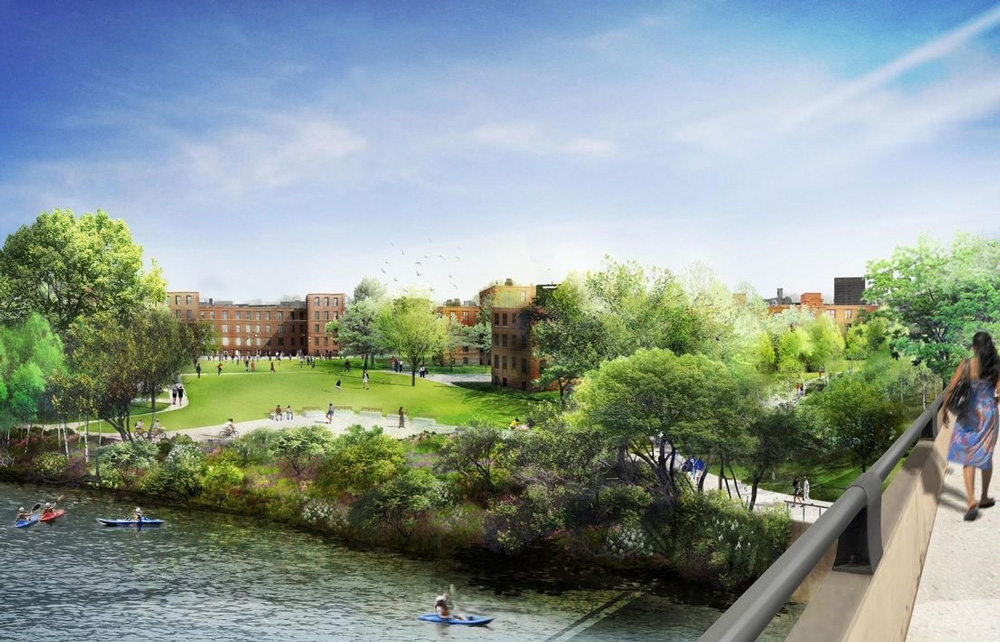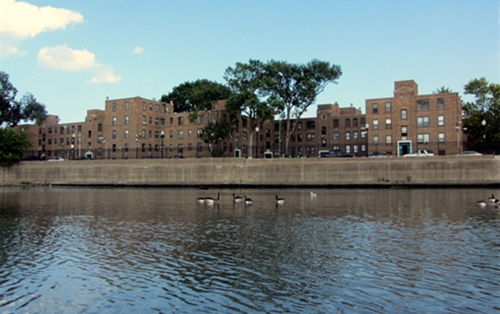Design, Nature, and Affordable Housing on the North Branch
The Chicago Community Trust is currently funding ten community-led riverfront projects through their Our Great Rivers grant. This piece is the ninth of a ten-part series highlighting these projects.

A rendering of the planned renovation of Lathrop Homes. Photo courtesy of Related Midwest.
When Lathrop Homes, one of Chicago’s first public housing sites, was first built in 1938, architects viewed the river as a nuisance rather than an asset. While the site boasted trees and green space, the Lathrop buildings were intentionally designed to turn away from the river.

Lathrop Homes from the Chicago River. Photo: David Wilson (flickr)
Now, as our perceptions of and desires to engage with the river are evolving, so too are the Lathrop Homes. After a multi-year community planning process, the site is evolving into a mixed-income housing development designed to connect to and leverage nearby transit, public schools, local parks, and the river.
The renovated development—being led by Lathrop Community Partners (a partnership between Related Midwest, Heartland Alliance, Bickerdike Redevelopment Corporation), Magellan Development Group, Ardmore Associates, and the Chicago Housing Authority—will offer 1,116 mixed-income apartments: 494 market-rate units, 222 affordable units, and 400 public housing units.
One of the goals for the redevelopment is to connect existing and new residents to the half-mile stretch of riverfront property along the North Branch of the Chicago River. The proposed plans for the site include an open concept with lighting, landscaping, and signage, drawing residents and community members to the river, which will be accessible for public use. The community will be encouraged to sit or picnic on the Great Lawn, the grand greenspace originally envisioned by Jens Jensen (the Chicago architect who designed the site in 1938). Residents and visitors alike will enjoy walking or biking along the Jimmy Thomas Nature Trail running alongside the river.
“Historically, public housing has been intentionally separated from the greater community, with the physical design of the space creating social barriers,” states Michael Goldberg, Executive Director of Heartland Alliance. “Lathrop really attempts to change that discourse by closing the physical gap, drawing people to the riverfront and by providing the space for people to learn and work together.”

A rendering showing public space along the riverfront at Lathrop Homes. Photo courtesy of Related Midwest.
Another goal of the Lathrop redevelopment is to develop opportunities for stewardship and programs that will activate the space by bringing community members together to connect at the riverfront. With support from funding from the Chicago Community Trust’s Our Great River’s Grant, the project team is working to establish a Friends of Lathrop group to coordinate activities and long-term care of the site.
This summer, Lathrop Community Partners, with the support of Friends of the Chicago River, gathered community members at the river for a kayaking event to begin soliciting interest the opportunities for environmental education on river plants and animals, children’s programs, kayaking, storytelling, river cleanup, and river advocacy. The site now also has a kayak launch, so that people can experience the river from the water. Invasive plants on the riverbanks are being replaced with native plants, paving the way for birds, turtles, and river otters to return to the waters.
The new Lathrop Homes offer a promising model for creating beautiful, equitable residential spaces where people feel connected to each other and the surrounding environment.
“From the time we started meeting with the community and stakeholders about Lathrop, there was an overwhelming desire to transform the riverfront into a place where people can enjoy the river and recreate,” Goldberg stated.
———————————————–
To see another story about connecting Chicago Housing Authority sites to the rivers, check out our post about the Beaubien Woods project!
Hanna Udischas is a former MPC Research Assistant.
